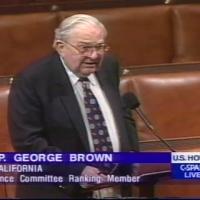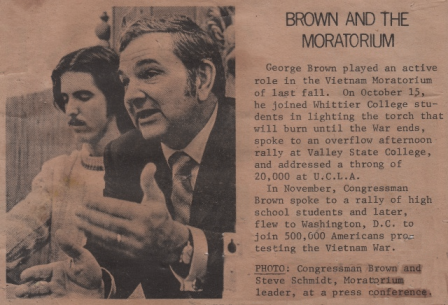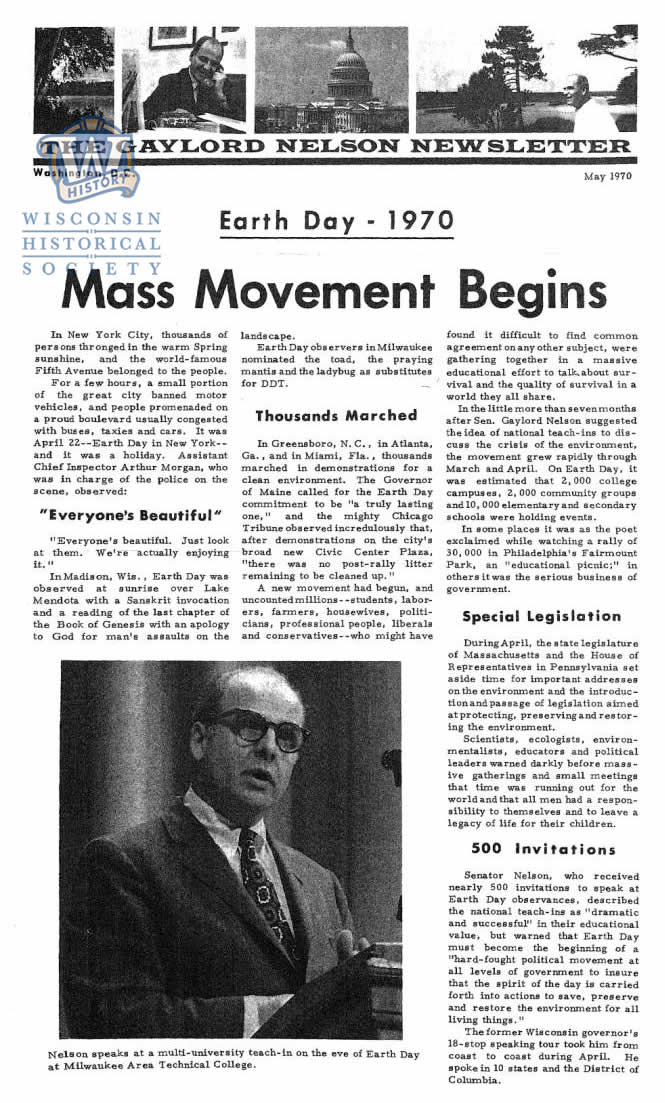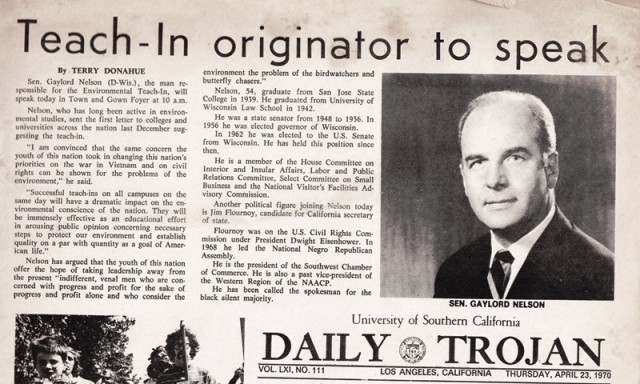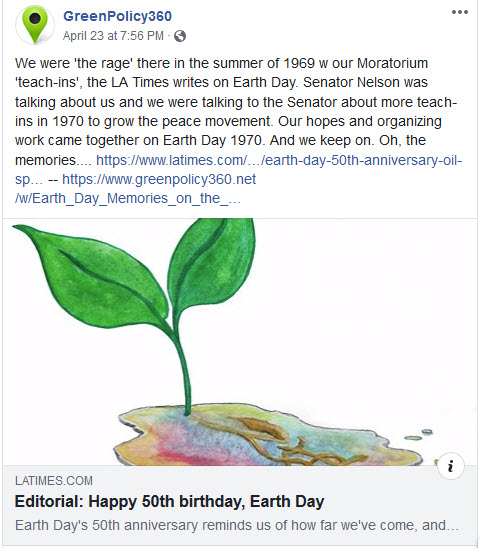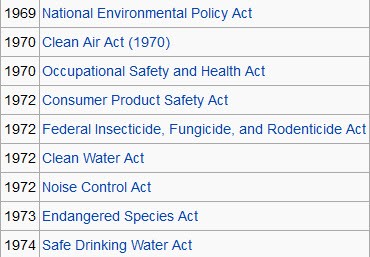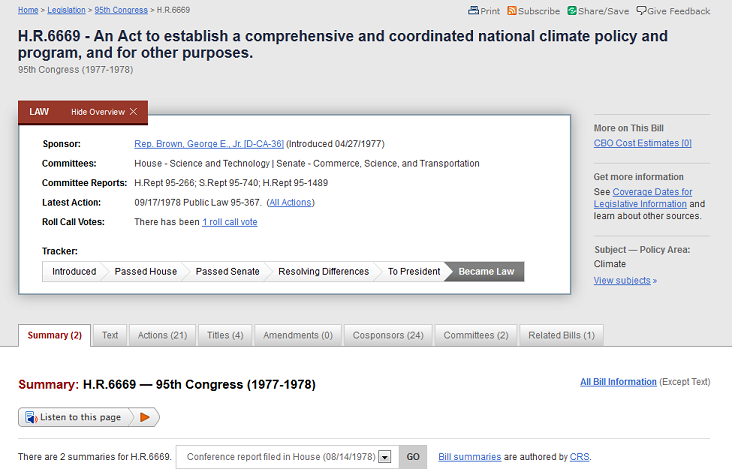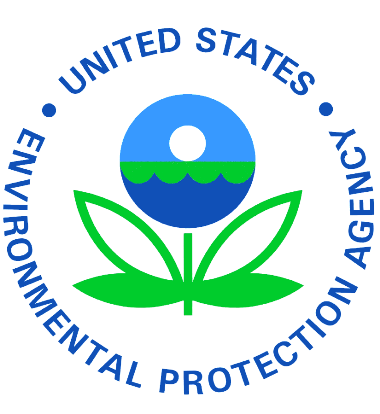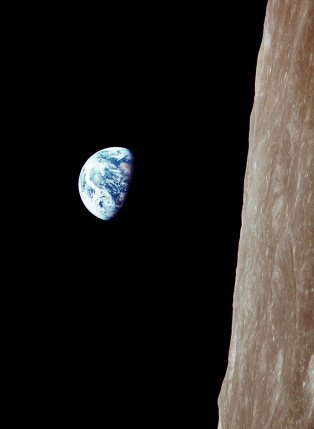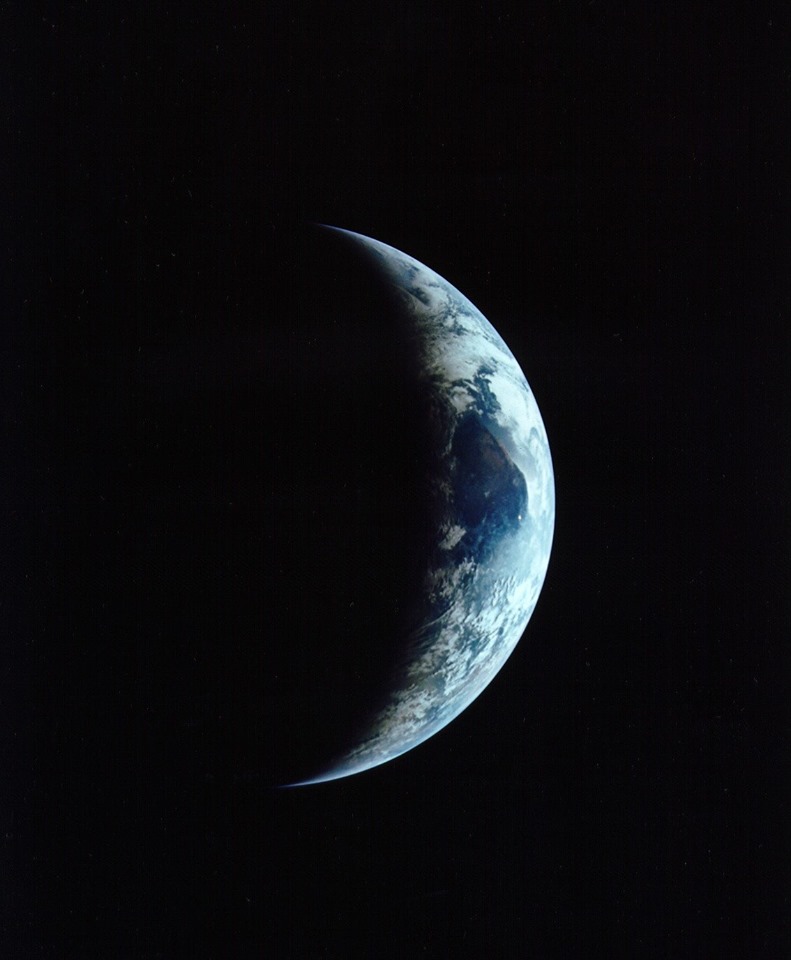Earth Day Memories on the 50th Anniversary: Difference between revisions
Siterunner (talk | contribs) No edit summary |
Siterunner (talk | contribs) No edit summary |
||
| (78 intermediate revisions by the same user not shown) | |||
| Line 1: | Line 1: | ||
Earth Day 2020 | |||
[[File:Earth Day 50th Golden Anniversary.gif]] | [[File:Earth Day 50th Golden Anniversary.gif]] | ||
<small> | <small>Original Art by 'OS' Olivia Schmidt / BY-NC-CC</small> | ||
<big>GreenPolicy360:</big> | |||
<big><big>On the 50th Anniversary</big></big> | <big><big>On the 50th Anniversary</big></big> | ||
<big><big>Memories on the Road to the First Earth Day</big></big> | |||
<big><big><big>'''Personal Memories on the Road to the First Earth Day'''</big></big></big> | |||
* https://www.greenpolicy360.net/w/Earth_Day_Memories_on_the_50th_Anniversary | |||
* https://www.greenpolicy360.net/w/File:Earth-Day.png | |||
It started on a Schwinn bike in the mid-1960s. My road to April 22, 1970. The day that would be called the first "Earth Day" began with a response by George E. Brown our newly elected local Congressman to my simple query -- help | [[File:ThinBlue-3 iss030e031276.jpg|link=https://www.greenpolicy360.net/images/ThinBlue_iss030e031276.jpg]] | ||
: <big><big>[https://www.greenpolicy360.net/w/PlanetCitizen PlanetCitizen.org] / [https://www.greenpolicy360.net/w/Earth_and_Space,_Politics Earth System Science] / [https://www.greenpolicy360.net/w/Earth_Science_Vital_Signs Measuring "Vital Signs"]</big></big> | |||
:: [https://www.greenpolicy360.net/w/File:You_can_manage_only_what_you_can_measure_Dr_David_Crisp,_OCO-2,_June_2014_m.jpg NASA: "You can manage only what you can measure"] | |||
| |||
By Steven Schmidt / [https://www.greenpolicy360.net/w/User:Siterunner GreenPolicy360 Siterunner] | |||
It started on a Schwinn bike in the mid-1960s. My road to '''April 22, 1970'''. The day that would be called '''the first "Earth Day"''' began years earlier with a response by George E. Brown, our newly elected local Congressman, to my young student's simple query -- can you help me? | |||
• https://www.greenpolicy360.net/w/George_E._Brown_Jr | • https://www.greenpolicy360.net/w/George_E._Brown_Jr | ||
I asked George, a | In his office, with my bicycle in the lobby, I asked George, a big man with a big smile, to help as I prepared for a high school debate arguing the risks of nuclear war and 'nth country proliferation'. A long friendship began as I attempted to sort out the school year's debate topic -- nuclear weapons and war. It was a subject about which the Congressman had strong feelings. | ||
Our era was the height of the Cold War and it had suddenly gotten | Our era was the height of the Cold War and it had suddenly gotten hotter in 1962 with a near catastrophe of US-Russia nuclear missile launches during the Cuban US-Russia Crisis. I wanted to better understand the international problems that could end in nuclear disaster. I figured a Congressman could at least point me in the right direction. | ||
My perspective as a kid from East Los Angeles was limited but I knew enough to know that 1962, one year before Brown was elected, came close to delivering that hot flash in the sky. | My perspective as a kid from East Los Angeles was limited but I knew enough to know that 1962, one year before Brown was elected, came close to delivering that hot flash in the sky. | ||
| Line 31: | Line 46: | ||
I didn't know that day that the man who was about to become a thirty year + friend, and mentor to me, was also a hard negotiator. He told me he'd help me with nuclear issues for my debating, if I would drive around on my bike in neighborhoods during his re-election campaigns and put up signs (and take down signs.) I eagerly agreed. | I didn't know that day that the man who was about to become a thirty year + friend, and mentor to me, was also a hard negotiator. He told me he'd help me with nuclear issues for my debating, if I would drive around on my bike in neighborhoods during his re-election campaigns and put up signs (and take down signs.) I eagerly agreed. | ||
Rep. Brown would go on to head up the science and technology committee in the House of Representatives, become instrumental in the creation of the EPA, the Clean Air Act, | |||
George, as I came to call him would draft the first National Climate Act in 1978 and shepherd its passage. He also was, at times, a controversial 'peacenik', he opposed the Vietnam War's policies. He was opposed to the nuclear weapons arms race. | : [[File:George Brown, Sci Com't.jpg]] | ||
Rep. Brown would go on to head up the science and technology committee in the House of Representatives, become instrumental in the creation of the EPA, the approval of the Clean Air Act, overseeing federal 'Big Science' initiatives, moving foward a first generation of NASA earth science missions, including LANDSAT and beginning the data baselines of [https://www.greenpolicy360.net/w/Category:Earth_System_Science new earth system science.] | |||
George, as I came to call him, would draft the first National Climate Act in 1978 and shepherd its passage. He also was, at times, a controversial 'peacenik', he opposed the Vietnam War's policies. He was opposed to the nuclear weapons arms race. | |||
That day he and I first met was at the beginning, before his decades long career and before I shared many moments and worked together over the years as both of our work ran on parallel paths. | That day he and I first met was at the beginning, before his decades long career and before I shared many moments and worked together over the years as both of our work ran on parallel paths. | ||
| Line 51: | Line 71: | ||
This is where I come back into the story of the first Earth Day. | This is where I come back into the story of the first Earth Day. | ||
I had gone off to USC in downtown LA, had become a student activist and met Rep. Allard Lowenstein D-NY, during one of my meetings. He asked me to fly to Washington and help organize a new anti-war group called the Vietnam Moratorium Committee. I met the other organizers, Sam Brown, Dave Hawk, David Mixner, Marge Sklenkar and Congressman Lowenstein hovered in the background. I signed up. | I had gone off to USC in downtown LA, had become a student activist and met Rep. Allard Lowenstein D-NY, during one of my meetings. He asked me to fly to Washington and help organize a new anti-war group called the Vietnam Moratorium Committee. I met the other organizers, Sam Brown, Dave Hawk, David Mixner, Marge Sklenkar and Congressman Lowenstein hovered in the background. [https://en.wikipedia.org/wiki/Moratorium_to_End_the_War_in_Vietnam I signed up.] | ||
My world dramatically changed as I returned to USC. It was time to pivot from a simpler life. I turned down my acceptance to Berkeley and decided USC would be the epicenter in California for the Moratorium. We'd be telling Berkeley students what to do, just the thought of our historically far-right campus changing stripes and going into the Free Speech Bay area to coordinate the statewide peace movement was enough motivation for me to go full out. | |||
We arranged to take over most of the USC Religious Center offices to coordinate Moratorium teach-ins, strikes, and California organizing. Congressman Brown was of great assistance and the first state-wide protest on October 15, 1969 became a huge event. | |||
At USC, we put together a peace day in Exposition Park. We expected a crowd of many thousands. As a state organizer I contacted Reverand Ralph Abernathy and invited him. I spoke, Rev. Abernathy spoke, Paul Schrade, the union leader who was shot when Bobby Kennedy was killed by Sirhan Sirhan, spoke. Harold Willens of Business Executives for Peace added the business community's voice. Marches went to City Hall and across Los Angeles. Tens of thousands marched and rallied, speaking out in Southern and Northern California. All together it was a public statement that was historic, the largest anti-war group, the Moratorium committee, held an unprecedented number of events in states across the nation and millions sent a resonant message to President Nixon. | |||
At USC, we put together a peace day in Exposition Park | |||
What we didn't know but would find out later was how close the nation and world came to commencing a nuclear conflict in 1969. | What we didn't know but would find out later was [https://www.greenpolicy360.net/w/File:Moratorium_October_15_1969.jpg how close the nation and world came to commencing a nuclear conflict in 1969]. | ||
Let's pause here -- it is more than important to slow down here and talk about another nuclear weapons close call. | Let's pause here -- it is more than important to slow down here and talk about another nuclear weapons close call. The reporting on this came from the National Security Council years later. Mort Halperin, [https://www.greenpolicy360.net/w/Roger_Morris_Bio Roger Morris], Dan Ellsberg would write about it. | ||
The reporting on this came from the National Security Council years later. Mort Halperin, [https://www.greenpolicy360.net/w/Roger_Morris_Bio Roger Morris], Dan Ellsberg would write about it. | |||
'''Nixon almost took the Vietnam war nuclear in November 1969''' | '''Nixon almost took the Vietnam war nuclear in November 1969''' | ||
Here, take a look at this passage from Dan Ellsberg's book, Doomsday Machine: Confessions of a Nuclear War Planner | Here, take a look at this passage from Dan Ellsberg's book, Doomsday Machine: Confessions of a Nuclear War Planner as written of by GreenPolicy360 and our associate, Strategic Demands -- | ||
"There was pressure to make the war larger" and "nuclear targets were picked" by the Nixon administration, the Pentagon Papers whistleblower revealed. | "There was pressure to make the war larger" and "nuclear targets were picked" by the Nixon administration, the Pentagon Papers whistleblower revealed. | ||
• https://www.greenpolicy360.net/w/The_Movement_and_the_Madman_-_PBS_-_March_2023 | |||
• https://www.strategicdemands.com/doomsday-machine/ | • https://www.strategicdemands.com/doomsday-machine/ | ||
| Line 88: | Line 107: | ||
As a leader of the anti-war efforts, I listened to Dan's revelations that found their way into my speeches, work, travels. The lies of the leaders of the country became top of mind when the facts of the war were revealed. That the president was close to dropping nuclear weapons to further escalate was not known to me at that time, but certainly our strategy of the Vietnam Moratorium Committee was to demonstrate to the President and country that mainstream American opposed the carnage and the failed policy of inserting the US into a civil war between North and South Vietnam. | As a leader of the anti-war efforts, I listened to Dan's revelations that found their way into my speeches, work, travels. The lies of the leaders of the country became top of mind when the facts of the war were revealed. That the president was close to dropping nuclear weapons to further escalate was not known to me at that time, but certainly our strategy of the Vietnam Moratorium Committee was to demonstrate to the President and country that mainstream American opposed the carnage and the failed policy of inserting the US into a civil war between North and South Vietnam. | ||
The Moratorium teach-ins were planned as a series of peace demonstrations into the spring of 1970 | The Moratorium teach-ins were planned as a series of peace demonstrations into the spring of 1970. We knew the protests had to have a positive message with more teach-ins. Our 1969 organizing led to 1970 direct action teach-ins and the environmental protection messages of the first Earth Day in April of 1970. | ||
················································································································ | |||
| Line 94: | Line 116: | ||
················································································································ | |||
'''How did the environmental Teach-ins that turned into Earth Day spring up?''' | '''How did the environmental Teach-ins that turned into Earth Day spring up?''' | ||
Senator Nelson later described how he came to put forward the idea of | Senator Nelson later described how he came to put forward the idea of a teach-ins for environmentalism. He spoke of the mass movement of the 1969/70 Vietnam Moratorium and our strategy of a *series of actions over months focusing on pressuring Congress. He was struck how peace teach-ins worked to spread the word, he said, after a trip to California to see the huge oil spill on California’s coast in 1969 and then reading media headlines of the work of Moratorium activists. | ||
"Senator Nelson read an article about college students organizing teach-ins to raise awareness on campuses about the Vietnam War. He thought that he could organize a teach-in for conservation issues. After a great deal of work, Nelson and numerous associates designated 22 April 1970 as the first Earth Day teach-in."'' | ::[[File:Rep George Brown and Steve Schmidt - Oct 15, 1969 - 448x305.png]] | ||
::<small><small>GreenPolicy360 founder Steve Schmidt at Press Conference with Congressman George Brown</small></small> | |||
::<small>1969</small> | |||
Congressman George E. Brown shared multiple peace and environment initiatives with Senator Nelson, who would explain later how he was inspired by our Moratorium work to "hold a nationwide environmental teach-in on April 22, 1970." A simple version of how Senator Nelson came to the idea of an Earth Day can be seen in a short explanation put out by the Senator's office. | |||
''''''"Senator Nelson read an article about college students organizing teach-ins to raise awareness on campuses about the Vietnam War. He thought that he could organize a teach-in for conservation issues. After a great deal of work, Nelson and numerous associates designated 22 April 1970 as the first Earth Day teach-in."''''' | |||
In the background, more was going on between Congressman Brown and Senator Nelson. | In the background, more was going on between Congressman Brown and Senator Nelson. | ||
| Line 109: | Line 138: | ||
This is when we, USC students first heard from Senator Nelson about our Moratorium work. The first talks led to strategizing, sharing between Congressman Brown and Senator Nelson how we wanted to go "mainstream", off the college campuses to build momentum, "a broad-based movement to put pressure on Congress". George Brown completely understood and agreed. He was an engineer who I was learning from, we had to have a strategy, a plan, and then we needed to make the plan real. Ours was a practical politics of goal and objectives. George was seeing an opportunity to create an umbrella federal environmental agency and was pushing for it. He knew, we knew, that Nixon had to be pressured politically. | This is when we, USC students first heard from Senator Nelson about our Moratorium work. The first talks led to strategizing, sharing between Congressman Brown and Senator Nelson how we wanted to go "mainstream", off the college campuses to build momentum, "a broad-based movement to put pressure on Congress". George Brown completely understood and agreed. He was an engineer who I was learning from, we had to have a strategy, a plan, and then we needed to make the plan real. Ours was a practical politics of goal and objectives. George was seeing an opportunity to create an umbrella federal environmental agency and was pushing for it. He knew, we knew, that Nixon had to be pressured politically. | ||
The Congressman was working his Congressional allies, including Senator Nelson about possibilities on two fronts -- ending the war and building a flourishing environmental era. Senator Nelson and George Brown were leaders | The Congressman was working his Congressional allies, including Senator Nelson about possibilities on two fronts -- ending the war and building a flourishing environmental era. Senator Nelson and George Brown were leaders in the House and Senate. Senator Nelson was one of few early opponents of the Vietnam war, and in the 60s was a key voice for conservation policies and growing environmental politics. He was known for talking economics and ecology. He saw the big picture and I found him easy to talk with with about the environmental movement writ large. | ||
| Line 117: | Line 146: | ||
David Brower, whom I was fortunate to | [https://americanarchive.org/catalog/cpb-aacip_27-9673ng8v David Brower], whom I was fortunate to work alongside years later with the Green Education Fund, also lit a fire under Senator Nelson during that oil spill period. My main takeaway is that Senator Nelson saw the war Moratorium and peace teach-ins we organized as a 'model' and we talked about what could be done and should be done. The Senator's 1969 trip to the Santa Barbara oil disaster was a turning point. The University of California at Santa Barbara became one of most active Moratorium campuses and led months of demonstrations against the oil spill. The students there 'worked' the Senator. Congressman Brown worked the Senator. Public outrage over the oil spill worked the Senator. California was acting to shape a new environmentalism. | ||
• https://en.wikipedia.org/wiki/1969_Santa_Barbara_oil_spill | • https://en.wikipedia.org/wiki/1969_Santa_Barbara_oil_spill | ||
| Line 124: | Line 153: | ||
There is so much more... | There is so much more... | ||
Let's remember the student teach-ins, the means we used to spread the word and we did. The Vietnam Moratorium Committee became the largest peace group and and when we talked to Senator Nelson and George Brown about | Let's remember the student teach-ins, the means we used to spread the word and we did. The Vietnam Moratorium Committee became the largest peace group and and when we talked to Senator Nelson and George Brown about our '''environmental teach-ins''' becoming a series of annual peace and environment events they got it and put their combined weight behind the effort. | ||
'''Teach-ins to Earth days''' | |||
* https://www.earthday.org/history/ | |||
The environmental movement | |||
[http://www.greenpolicy360.net/w/File:Env_policy_laws_US_'the_beginning'_of_env_era.jpg @GreenPolicy360, 'The beginning of the modern environmental era'] | |||
[https://www.greenpolicy360.net/mw/images/1969_beginnings_of_the_modern_environmental_movement.pdf <big>'''Beginnings of the Modern Environmental Movement'''</big>] | |||
:* <small>https://greenpolicy360.net/images/1969_beginnings_of_the_modern_environmental_movement.pdf</small> | |||
From an [https://www.nasa.gov/multimedia/imagegallery/image_feature_1249.html '''Earthrise moment'''], to the Moratorium teach-ins and demonstrations, Senator Nelson was impressed he explained in California visit with us. He saw teach-ins as a model for what became, with his special emphasis and with Denis Hayes joining the planning team, the 1970 Earth Day was launched. What quickly followed in the 1970s was the passage of the first generation of US environmental protection legislation. | |||
• http://www.greenpolicy360.net/w/Environmental_movement | |||
• [http://www.greenpolicy360.net/images/Can_our_environment_be_saved_George_Brown-Omnibus_Environmental_Bill_1969.pdf George Brown on the Omnibus Environmental Bill, 1969] | |||
• https://www.greenpolicy360.net/w/Ethics_and_Climate_Change | |||
Looking back we can see a 'whole earth environmental movement' springing forth from the global realization passed on to us by the NASA Apollo missions, and student activism shaping a new generation and modern environmental movement. | |||
The new vision went beyond the destruction of war to construct an environmental foundation that lasts to this day, even as the current president attempts to roll back and destroy decades of progress. | The new vision went beyond the destruction of war to construct an environmental foundation that lasts to this day, even as the current president attempts to roll back and destroy decades of progress. | ||
································································································································································· | |||
[[File:Sen Nelson Earth Day newsletter 1970.jpg]] | [[File:Sen Nelson Earth Day newsletter 1970.jpg]] | ||
'''On Earth Day 1970''' Senator Nelson was busy, he had over 500 invitations to speak. He began the day on the East coast and swung west. His final stop was at our university, the University of Southern California, USC. [https://www.greenpolicy360.net/w/File:USC_Daily_Trojan_Sen_Nelson_speech_day_after_first_Earth_Day_.jpg '''"Teach-In originator"'''] will speak was how the campus newspaper headline described the visit. The campus news had little to say about the background and SC's involvement in the teach-ins that led to the April 22, 1970 environmental "Earth Day teach-ins" and significance of '''the first "Earth Day"''' even as we, the students directly involved, greatly appreciated the good Senator's coast-to-coast journey and the full circle reality from Earth Day teach-in planning to realization. | |||
Senator Gaylord Nelson at USC spoke out: ''"I am convinced that the same concerns the youth of this nation took in changing this nation's priorities on the war in Vietnam and on civil rights can be shown for the problems of the environment."'' | |||
''"Successful teach-ins on all campuses on the same day will have a dramatic impact on the environmental conscience of the nation. They will be immensely effective as an educational effort in arousing public opinion concerning necessary steps to protect our environment and establish quality on a par with quality as a goal of American life."'' | |||
''Nelson... argued that the youth of this nation offer the hope of taking leadership away from the present "indifferent, venal men who are concerned with progress and profit for the sake of progress and profit alone and who consider the environment the problem of the birdwatchers and butterfly chasers."'' | |||
The reporters at the campus Daily Trojan did not provide background on how Senator Nelson was influenced by USC students in the origination of the peace 'teach-ins' and founding of the Moratorium organization that the Senator was referring to in changing 'this nation's priorities'. In fact, the invitation we gave to Senator Nelson to speak at USC was a summing up our previous talks and ideas shared. He was speaking of our work and his travel across the nation on Earth Day came after previous discussions about originating environmental teach-ins and an Earth Day. | |||
[[File:USC Daily Trojan Sen Nelson speech day after first Earth Day .jpg]] | |||
<small>Senator Nelson arrives to congratulate us at USC. Thank you too Senator</small> | |||
::::[[File:Earth Day 50 years on.jpg]] | |||
::::<small>* https://greenpolicy360.net/w/File:Earth_Day_50_years_on.jpg</small> | |||
::::··················································································································· | |||
| Line 161: | Line 242: | ||
'''Today, how | '''Today, here's how Earth Day Teach-in coordinator Denis Hayes describe the positive impacts of the first Earth Day''' -- | ||
• https://www.seattletimes.com/opinion/in-2020-earth-day-will-be-nov-3/ | • https://www.seattletimes.com/opinion/in-2020-earth-day-will-be-nov-3/ | ||
| Line 183: | Line 264: | ||
:• National Forest Management Act'' | :• National Forest Management Act'' | ||
''In the 10 years following Earth Day, bold new laws changed the direction of the United States economy more profoundly than any other period in history, except perhaps the New Deal.'' | ''In the 10 years following Earth Day, bold new laws and a new Environmental Protection Agecny changed the direction of the United States economy more profoundly than any other period in history, except perhaps the New Deal.'' | ||
GreenPolicy360: Yes, the new Environmental Movement acted to push the US Congress, and yes Congress responded: | |||
[http://www.greenpolicy360.net/mw/images/EPA_History_Xin_Liu-2010.pdf <big>'''EPA History'''</big>] | |||
Congressman George Brown was a key player in environmental legislation and in the founding the Environmental Protection Agency, the EPA. | |||
As the LA Times noted (without pomp or circumstance) in George's [https://www.latimes.com/archives/la-xpm-1999-jul-17-mn-56747-story.html obituary in 1999]: "He championed the creation of the federal Environmental Protection Agency". The creation of the EPA was in many ways Congressman George Brown's vision achieved..." | |||
[[File: Environmental Protection Agency logo.png]] | |||
The founding of the EPA was based on new realizations of science and the environment. The vision of the "Whole Earth" that began with unprecedented Apollo photos on the cover of Life magazine in January 1969 led to a coming together of education, students 'teach-ins', scientific space missions studying earth systems for the first time, and popular demands for environmental protections. | |||
A leader and a chairperson on the House science committee for over 30 years, George legislatively engineered an array of science efforts, including one that greens look to as prescient -- climate science. | |||
<big><big>'''From California to the World'''</big></big> | |||
* https://www.greenpolicy360.net/w/Green_Best_Practices | |||
* https://www.greenpolicy360.net/w/Category:Environmental_Laws | |||
GreenPolicy360 Siterunner: In the early years of the [https://www.greenpolicy360.net/w/Environmental_movement '''modern environmental movement'''], a conscious effort was made to construct a foundation of environmental laws and regulations on which a multi-year environmental protection framework could be built. Your GreenPolicy360 founder was one of those who believed in this constructive paradigm, using model legislation that could be locally developed, often in our state of California, then shared, 'exported' as we used to say, 'to the Feds' for adoption at the national level. The history here provides an ongoing ''modus operandi'' from the 60s and 70s until now as we deal with the pressing local, national, and international/global environmental threats and crises. We, at GreenPolicy360, call this [https://www.greenpolicy360.net/w/Green_Best_Practices '''"green best practices"''']. Best practices is a model for sharing, networking, building on success and action. Templates and models, best practices made openly available, are our plans for having multiplier effects -- and it is our ongoing mission. A strong and resilient legal foundation and framework of environmental laws is an essential part of our overall work. We encourage you to join in as citizens of every nation, within your multiple and diverse legal systems and, we must add, as [https://www.greenpolicy360.net/w/Planet_Citizens '''planet citizens''']. | |||
* https://www.greenpolicy360.net/mw/index.php?title=Category:Countries | |||
* https://www.greenpolicy360.net/w/Planet_Citizen_Action | |||
* https://www.greenpolicy360.net/w/Climate_Problems,_Climate_Solutions | |||
···································· | ···································· | ||
| Line 198: | Line 316: | ||
:Earthrise | :'''Earthrise''' | ||
:Apollo 8, December 24, 1968 | :Apollo 8, December 24, 1968 | ||
| Line 207: | Line 325: | ||
Amid the turmoil of the times, some good news came in the form of the first vision of our planet Earth from astronauts preparing for a moon mission landing. | Amid the turmoil of the times, some good news came in the form of the first vision of our planet Earth from astronauts preparing for a moon mission landing. | ||
The Earthrise image | The Earthrise image in many ways became a starting point, a cosmic shift and beginning of a modern environmental movement as we could see ourselves on a common mission as 'planet citizens'. | ||
The | The first-ever full-color images of Planet Earth were ripples and waves of a new green politics across the world. | ||
The environmental movement that sprang from a global realization passed on to us by the NASA Apollo missions continues shaping a new generation and modern environmental movement. Global consciousness is moving into the mainstream and [https://www.greenpolicy360.net/w/File:Blue_Marble_photo_-_Apollo_17.jpg humanity's first views of Planet Earth], now described as the most viewed photos of all time, are ripples and waves of a new green politics across the world. | |||
Our job? To care for our planet, our blue-green living home rising against a dark, vast expanse of space. | Our job? To care for our planet, our blue-green living home rising against a dark, vast expanse of space. | ||
We are [http://planetcitizens.org planet citizens] on a [http://planetcitizen.org planet citizen voyage]. Welcome onboard! | |||
[[File:Apollo 11 returning to home planet Earth.jpg]] | |||
<small>Memories of the First Earth Day</small> | |||
[[File:Earth Day 2020 - 50th Anniversary.png]] | [[File:Earth Day 2020 - 50th Anniversary.png]] | ||
<small> | :<small><small>* https://www.greenpolicy360.net/w/File:Earth_Day_50th_Golden_Anniversary.gif</small></small> | ||
:<small>Original Art by Olivia Schmidt / BY-NC | |||
:Creative Commons / Use w/ Attribution + Non-commercial</small> | |||
🌎 | |||
[[Category:About Us]] | |||
[[Category:Anthropocene]] | [[Category:Anthropocene]] | ||
[[Category:Atmospheric Science]] | [[Category:Atmospheric Science]] | ||
| Line 242: | Line 365: | ||
[[Category:Climate Change]] | [[Category:Climate Change]] | ||
[[Category:Earth]] | [[Category:Earth]] | ||
[[Category:Eco-ethics]] | |||
[[Category:Eco-nomics]] | [[Category:Eco-nomics]] | ||
[[Category:Eco-Spirituality]] | |||
[[Category:Earth Day]] | [[Category:Earth Day]] | ||
[[Category:EOS eco Operating System]] | [[Category:EOS eco Operating System]] | ||
| Line 269: | Line 394: | ||
[[Category:Natural Resources]] | [[Category:Natural Resources]] | ||
[[Category:Natural Rights]] | [[Category:Natural Rights]] | ||
[[Category:Nature]] | |||
[[Category:Networking]] | [[Category:Networking]] | ||
[[Category:New Definitions of National Security]] | [[Category:New Definitions of National Security]] | ||
| Line 291: | Line 417: | ||
[[Category:Women's Rights]] | [[Category:Women's Rights]] | ||
[[Category:World Wide Web]] | [[Category:World Wide Web]] | ||
[[Category:Youth]] | |||
Latest revision as of 14:57, 19 August 2024
Earth Day 2020
Original Art by 'OS' Olivia Schmidt / BY-NC-CC
GreenPolicy360:
On the 50th Anniversary
Personal Memories on the Road to the First Earth Day
By Steven Schmidt / GreenPolicy360 Siterunner
It started on a Schwinn bike in the mid-1960s. My road to April 22, 1970. The day that would be called the first "Earth Day" began years earlier with a response by George E. Brown, our newly elected local Congressman, to my young student's simple query -- can you help me?
• https://www.greenpolicy360.net/w/George_E._Brown_Jr
In his office, with my bicycle in the lobby, I asked George, a big man with a big smile, to help as I prepared for a high school debate arguing the risks of nuclear war and 'nth country proliferation'. A long friendship began as I attempted to sort out the school year's debate topic -- nuclear weapons and war. It was a subject about which the Congressman had strong feelings.
Our era was the height of the Cold War and it had suddenly gotten hotter in 1962 with a near catastrophe of US-Russia nuclear missile launches during the Cuban US-Russia Crisis. I wanted to better understand the international problems that could end in nuclear disaster. I figured a Congressman could at least point me in the right direction.
My perspective as a kid from East Los Angeles was limited but I knew enough to know that 1962, one year before Brown was elected, came close to delivering that hot flash in the sky.
Schools practiced the Duck and Cover and those sirens became real. The possibility of death by nuclear weapons was not far off. I know this both viscerally and intellectually. My thought in contacting the Congressman was that I could get a debate team advantage by knowing the details of nuclear weapons and I knew Congressman Brown was in the news talking about them.
I didn't know that day that the man who was about to become a thirty year + friend, and mentor to me, was also a hard negotiator. He told me he'd help me with nuclear issues for my debating, if I would drive around on my bike in neighborhoods during his re-election campaigns and put up signs (and take down signs.) I eagerly agreed.
Rep. Brown would go on to head up the science and technology committee in the House of Representatives, become instrumental in the creation of the EPA, the approval of the Clean Air Act, overseeing federal 'Big Science' initiatives, moving foward a first generation of NASA earth science missions, including LANDSAT and beginning the data baselines of new earth system science.
George, as I came to call him, would draft the first National Climate Act in 1978 and shepherd its passage. He also was, at times, a controversial 'peacenik', he opposed the Vietnam War's policies. He was opposed to the nuclear weapons arms race.
That day he and I first met was at the beginning, before his decades long career and before I shared many moments and worked together over the years as both of our work ran on parallel paths.
But let me go back to the Schwinn and another memory.
The X-ray George showed me in his office. It left a strong imprint on my consciousness as a kid growing up in the worst years of LA smog. I had asthma as did many kids and the X-ray was of a kid's lungs, after death. The impairment, the darkness, was evident and George carried on that day, the trained engineer that he was, talking about how 'we' needed to clean the air up, to make LA a model, California a model of what could happen if the people protected the kids. I don't remember all the details of his plan, but I remember the X-ray.
The Congressman was a man of action and I have to say his words led to deeds. He made plans, I learned over the years, engineer's plan, and he pursued them with his rumpled suits and pipe smoking and his twinkling eye. He also knew politics and could persuade, as he did, politicos right and left.
So let's talk the biggest politico of the Republican Party, Richard M. Nixon from Whittier, a nearby town and a man that George Brown knew he had to work with if he was going to get his agenda accomplished.
Up Top, Clean Air
Nixon would be elected in 1968 on a promise to end the Vietnam War. The political world was in upheaval with assassinations of Martin Luther King and Robert Kennedy. Riots had broken out. The 68 Democratic convention in Chicago was a violent riot in itself and Nixon hoped to take advantage of the politics of the day, even as he clamped down on a strongly growing peace movement.
This is where I come back into the story of the first Earth Day.
I had gone off to USC in downtown LA, had become a student activist and met Rep. Allard Lowenstein D-NY, during one of my meetings. He asked me to fly to Washington and help organize a new anti-war group called the Vietnam Moratorium Committee. I met the other organizers, Sam Brown, Dave Hawk, David Mixner, Marge Sklenkar and Congressman Lowenstein hovered in the background. I signed up.
My world dramatically changed as I returned to USC. It was time to pivot from a simpler life. I turned down my acceptance to Berkeley and decided USC would be the epicenter in California for the Moratorium. We'd be telling Berkeley students what to do, just the thought of our historically far-right campus changing stripes and going into the Free Speech Bay area to coordinate the statewide peace movement was enough motivation for me to go full out.
We arranged to take over most of the USC Religious Center offices to coordinate Moratorium teach-ins, strikes, and California organizing. Congressman Brown was of great assistance and the first state-wide protest on October 15, 1969 became a huge event.
At USC, we put together a peace day in Exposition Park. We expected a crowd of many thousands. As a state organizer I contacted Reverand Ralph Abernathy and invited him. I spoke, Rev. Abernathy spoke, Paul Schrade, the union leader who was shot when Bobby Kennedy was killed by Sirhan Sirhan, spoke. Harold Willens of Business Executives for Peace added the business community's voice. Marches went to City Hall and across Los Angeles. Tens of thousands marched and rallied, speaking out in Southern and Northern California. All together it was a public statement that was historic, the largest anti-war group, the Moratorium committee, held an unprecedented number of events in states across the nation and millions sent a resonant message to President Nixon.
What we didn't know but would find out later was how close the nation and world came to commencing a nuclear conflict in 1969.
Let's pause here -- it is more than important to slow down here and talk about another nuclear weapons close call. The reporting on this came from the National Security Council years later. Mort Halperin, Roger Morris, Dan Ellsberg would write about it.
Nixon almost took the Vietnam war nuclear in November 1969
Here, take a look at this passage from Dan Ellsberg's book, Doomsday Machine: Confessions of a Nuclear War Planner as written of by GreenPolicy360 and our associate, Strategic Demands --
"There was pressure to make the war larger" and "nuclear targets were picked" by the Nixon administration, the Pentagon Papers whistleblower revealed.
• https://www.greenpolicy360.net/w/The_Movement_and_the_Madman_-_PBS_-_March_2023
• https://www.strategicdemands.com/doomsday-machine/
• https://www.amazon.com/Doomsday-Machine-Confessions-Nuclear-Planner-ebook/dp/B074HZMN71/
Richard Nixon and Henry Kissinger had a plan to end the war in Vietnam by escalating and going even beyond B-29 bombings with greater magnitude than the bombing tonnage of WWII. The nuclear war plans were drawn and ready to go -- what stopped it?
The October 1969 nationwide Moratorium...
I had become a friend of Dan Ellsberg as he went through his now well known preparations and release of the "Pentagon Papers".
As a leader of the anti-war efforts, I listened to Dan's revelations that found their way into my speeches, work, travels. The lies of the leaders of the country became top of mind when the facts of the war were revealed. That the president was close to dropping nuclear weapons to further escalate was not known to me at that time, but certainly our strategy of the Vietnam Moratorium Committee was to demonstrate to the President and country that mainstream American opposed the carnage and the failed policy of inserting the US into a civil war between North and South Vietnam.
The Moratorium teach-ins were planned as a series of peace demonstrations into the spring of 1970. We knew the protests had to have a positive message with more teach-ins. Our 1969 organizing led to 1970 direct action teach-ins and the environmental protection messages of the first Earth Day in April of 1970.
················································································································
An astonishing success, the first Earth Day in 1970 was celebrated by some 20 million Americans on 2,000 college campuses, at 10,000 primary and secondary schools, and in hundreds of communities. More than 40 years later, its commemoration attracts hundreds of millions of people in countries all over the world.
················································································································
How did the environmental Teach-ins that turned into Earth Day spring up?
Senator Nelson later described how he came to put forward the idea of a teach-ins for environmentalism. He spoke of the mass movement of the 1969/70 Vietnam Moratorium and our strategy of a *series of actions over months focusing on pressuring Congress. He was struck how peace teach-ins worked to spread the word, he said, after a trip to California to see the huge oil spill on California’s coast in 1969 and then reading media headlines of the work of Moratorium activists.
- GreenPolicy360 founder Steve Schmidt at Press Conference with Congressman George Brown
- 1969
Congressman George E. Brown shared multiple peace and environment initiatives with Senator Nelson, who would explain later how he was inspired by our Moratorium work to "hold a nationwide environmental teach-in on April 22, 1970." A simple version of how Senator Nelson came to the idea of an Earth Day can be seen in a short explanation put out by the Senator's office.
'"Senator Nelson read an article about college students organizing teach-ins to raise awareness on campuses about the Vietnam War. He thought that he could organize a teach-in for conservation issues. After a great deal of work, Nelson and numerous associates designated 22 April 1970 as the first Earth Day teach-in."
In the background, more was going on between Congressman Brown and Senator Nelson.
This is when we, USC students first heard from Senator Nelson about our Moratorium work. The first talks led to strategizing, sharing between Congressman Brown and Senator Nelson how we wanted to go "mainstream", off the college campuses to build momentum, "a broad-based movement to put pressure on Congress". George Brown completely understood and agreed. He was an engineer who I was learning from, we had to have a strategy, a plan, and then we needed to make the plan real. Ours was a practical politics of goal and objectives. George was seeing an opportunity to create an umbrella federal environmental agency and was pushing for it. He knew, we knew, that Nixon had to be pressured politically.
The Congressman was working his Congressional allies, including Senator Nelson about possibilities on two fronts -- ending the war and building a flourishing environmental era. Senator Nelson and George Brown were leaders in the House and Senate. Senator Nelson was one of few early opponents of the Vietnam war, and in the 60s was a key voice for conservation policies and growing environmental politics. He was known for talking economics and ecology. He saw the big picture and I found him easy to talk with with about the environmental movement writ large.
The economy is a wholly owned subsidiary of the environment, not the other way around. -- Senator Gaylord Nelson
• https://en.wikipedia.org/wiki/Environmentalism
David Brower, whom I was fortunate to work alongside years later with the Green Education Fund, also lit a fire under Senator Nelson during that oil spill period. My main takeaway is that Senator Nelson saw the war Moratorium and peace teach-ins we organized as a 'model' and we talked about what could be done and should be done. The Senator's 1969 trip to the Santa Barbara oil disaster was a turning point. The University of California at Santa Barbara became one of most active Moratorium campuses and led months of demonstrations against the oil spill. The students there 'worked' the Senator. Congressman Brown worked the Senator. Public outrage over the oil spill worked the Senator. California was acting to shape a new environmentalism.
• https://en.wikipedia.org/wiki/1969_Santa_Barbara_oil_spill
There is so much more...
Let's remember the student teach-ins, the means we used to spread the word and we did. The Vietnam Moratorium Committee became the largest peace group and and when we talked to Senator Nelson and George Brown about our environmental teach-ins becoming a series of annual peace and environment events they got it and put their combined weight behind the effort.
Teach-ins to Earth days
@GreenPolicy360, 'The beginning of the modern environmental era'
Beginnings of the Modern Environmental Movement
From an Earthrise moment, to the Moratorium teach-ins and demonstrations, Senator Nelson was impressed he explained in California visit with us. He saw teach-ins as a model for what became, with his special emphasis and with Denis Hayes joining the planning team, the 1970 Earth Day was launched. What quickly followed in the 1970s was the passage of the first generation of US environmental protection legislation.
• http://www.greenpolicy360.net/w/Environmental_movement
• George Brown on the Omnibus Environmental Bill, 1969
• https://www.greenpolicy360.net/w/Ethics_and_Climate_Change
Looking back we can see a 'whole earth environmental movement' springing forth from the global realization passed on to us by the NASA Apollo missions, and student activism shaping a new generation and modern environmental movement.
The new vision went beyond the destruction of war to construct an environmental foundation that lasts to this day, even as the current president attempts to roll back and destroy decades of progress.
·································································································································································
On Earth Day 1970 Senator Nelson was busy, he had over 500 invitations to speak. He began the day on the East coast and swung west. His final stop was at our university, the University of Southern California, USC. "Teach-In originator" will speak was how the campus newspaper headline described the visit. The campus news had little to say about the background and SC's involvement in the teach-ins that led to the April 22, 1970 environmental "Earth Day teach-ins" and significance of the first "Earth Day" even as we, the students directly involved, greatly appreciated the good Senator's coast-to-coast journey and the full circle reality from Earth Day teach-in planning to realization.
Senator Gaylord Nelson at USC spoke out: "I am convinced that the same concerns the youth of this nation took in changing this nation's priorities on the war in Vietnam and on civil rights can be shown for the problems of the environment."
"Successful teach-ins on all campuses on the same day will have a dramatic impact on the environmental conscience of the nation. They will be immensely effective as an educational effort in arousing public opinion concerning necessary steps to protect our environment and establish quality on a par with quality as a goal of American life."
Nelson... argued that the youth of this nation offer the hope of taking leadership away from the present "indifferent, venal men who are concerned with progress and profit for the sake of progress and profit alone and who consider the environment the problem of the birdwatchers and butterfly chasers."
The reporters at the campus Daily Trojan did not provide background on how Senator Nelson was influenced by USC students in the origination of the peace 'teach-ins' and founding of the Moratorium organization that the Senator was referring to in changing 'this nation's priorities'. In fact, the invitation we gave to Senator Nelson to speak at USC was a summing up our previous talks and ideas shared. He was speaking of our work and his travel across the nation on Earth Day came after previous discussions about originating environmental teach-ins and an Earth Day.
Senator Nelson arrives to congratulate us at USC. Thank you too Senator
- ···················································································································
What legislative accomplishments did the first Earth Day movement push forward and enable?
Here's how we at GreenPolicy360 describe the first-generation environmental foundation of environmental protections that the Earth Day movement and pressure helped to build --
First U.S. National Climate Act
• https://www.greenpolicy360.net/w/File:US_Public_Law_95-367.png
Today, here's how Earth Day Teach-in coordinator Denis Hayes describe the positive impacts of the first Earth Day --
• https://www.seattletimes.com/opinion/in-2020-earth-day-will-be-nov-3/
One month after the 1970 election, the Clean Air Act of 1970 passed the Senate unanimously and the House with just one dissenting vote.
In short order, Congress also passed the:
- • Clean Water Act
- • Occupational Health and Safety Act
- • Marine Mammal Protection Act
- • Endangered Species Act
- • Safe Drinking Water Act
- • Set Corporate Average Fuel Economy (CAFÉ) standards for cars
- • Federal Insecticide, Fungicide, and Rodenticide Act
- • Resource Conservation and Recovery Act
- • Toxic Substances Control Act
- • National Forest Management Act
In the 10 years following Earth Day, bold new laws and a new Environmental Protection Agecny changed the direction of the United States economy more profoundly than any other period in history, except perhaps the New Deal.
GreenPolicy360: Yes, the new Environmental Movement acted to push the US Congress, and yes Congress responded:
Congressman George Brown was a key player in environmental legislation and in the founding the Environmental Protection Agency, the EPA.
As the LA Times noted (without pomp or circumstance) in George's obituary in 1999: "He championed the creation of the federal Environmental Protection Agency". The creation of the EPA was in many ways Congressman George Brown's vision achieved..."
The founding of the EPA was based on new realizations of science and the environment. The vision of the "Whole Earth" that began with unprecedented Apollo photos on the cover of Life magazine in January 1969 led to a coming together of education, students 'teach-ins', scientific space missions studying earth systems for the first time, and popular demands for environmental protections.
A leader and a chairperson on the House science committee for over 30 years, George legislatively engineered an array of science efforts, including one that greens look to as prescient -- climate science.
From California to the World
GreenPolicy360 Siterunner: In the early years of the modern environmental movement, a conscious effort was made to construct a foundation of environmental laws and regulations on which a multi-year environmental protection framework could be built. Your GreenPolicy360 founder was one of those who believed in this constructive paradigm, using model legislation that could be locally developed, often in our state of California, then shared, 'exported' as we used to say, 'to the Feds' for adoption at the national level. The history here provides an ongoing modus operandi from the 60s and 70s until now as we deal with the pressing local, national, and international/global environmental threats and crises. We, at GreenPolicy360, call this "green best practices". Best practices is a model for sharing, networking, building on success and action. Templates and models, best practices made openly available, are our plans for having multiplier effects -- and it is our ongoing mission. A strong and resilient legal foundation and framework of environmental laws is an essential part of our overall work. We encourage you to join in as citizens of every nation, within your multiple and diverse legal systems and, we must add, as planet citizens.
····································
Earthrise to Earth Day
Remembering how, on the day before Christmas, December 24, 1968 the famous Earthrise photo was taken. The astronauts on Apollo 8 said it was a surprise, an unplanned magical moment when the Earth suddenly appeared through a window of orbiting spaceship. They scrambled to find a camera, put color film in it, since the living colors of the Earth were so vivid against the complete lifeless darkness of space. The moment humanity saw our planet suddenly arising from beyond the moon was life changing.
- Earthrise
- Apollo 8, December 24, 1968
Amid the turmoil of the times, some good news came in the form of the first vision of our planet Earth from astronauts preparing for a moon mission landing.
The Earthrise image in many ways became a starting point, a cosmic shift and beginning of a modern environmental movement as we could see ourselves on a common mission as 'planet citizens'.
The first-ever full-color images of Planet Earth were ripples and waves of a new green politics across the world.
The environmental movement that sprang from a global realization passed on to us by the NASA Apollo missions continues shaping a new generation and modern environmental movement. Global consciousness is moving into the mainstream and humanity's first views of Planet Earth, now described as the most viewed photos of all time, are ripples and waves of a new green politics across the world.
Our job? To care for our planet, our blue-green living home rising against a dark, vast expanse of space.
We are planet citizens on a planet citizen voyage. Welcome onboard!
Memories of the First Earth Day
- Original Art by Olivia Schmidt / BY-NC
- Creative Commons / Use w/ Attribution + Non-commercial
🌎
- About Us
- Anthropocene
- Atmospheric Science
- Biodiversity
- Biosphere
- Citizen Science
- Civil Rights
- Clean Air
- Clean Water
- Climate Change
- Earth
- Eco-ethics
- Eco-nomics
- Eco-Spirituality
- Earth Day
- EOS eco Operating System
- Earth360
- EarthPOV
- Earth Observations
- Earth Science
- Ecofeminism
- Ecology Studies
- Education
- Energy
- Environmental Laws
- Environmental Protection
- Environmental Security
- Environmental Security, National Security
- Food
- Global Security
- Global Warming
- Green Best Practices
- Green Networking
- GreenPolicy360
- Green Politics
- Health
- Human Rights
- Money in Politics
- Natural Resources
- Natural Rights
- Nature
- Networking
- New Definitions of National Security
- Overview Effect
- Peace
- Planet Citizen
- Planet Citizens
- Planet Scientist
- Planet Citizens, Planet Scientists
- Renewable Energy
- Resilience
- Seventh Generation Sustainability
- Solar Energy
- Strategic Demands
- Sustainability
- Sustainability Policies
- ThinBlueLayer
- US Environmental Protection Agency
- Water Quality
- Whole Earth
- Wildlife
- Women's Rights
- World Wide Web
- Youth


